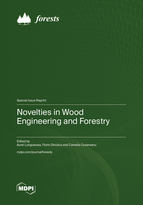Novelties in Wood Engineering and Forestry
A special issue of Forests (ISSN 1999-4907). This special issue belongs to the section "Wood Science and Forest Products".
Deadline for manuscript submissions: closed (31 August 2023) | Viewed by 17973
Special Issue Editors
Interests: wood composite material; lighter wood particles; the physics of wood; the quality of composites
Special Issues, Collections and Topics in MDPI journals
Interests: wood science; non-human forest products; dendrocronology; classification and exploitation of forest resources
Special Issues, Collections and Topics in MDPI journals
Interests: furniture; lignocellulosic composites; wood; design; wood civilization
Special Issues, Collections and Topics in MDPI journals
Special Issue Information
Dear Colleagues,
This Special Issue will deal with the forestry and wood processing aspects. In particular, in the field of forestry, the Special Issue invites research on genetics, forest roads, biomass, and main and byproducts of forests, log exploitation, primary processing of round wood, quality of exploited, wood and the role of forest and forest ecosystem on the environment. Regarding the wood processing part, this Special Issue will receive works on cutting round wood in timber and veneers, wood processing to obtain furniture, parquet, doors and windows, wood biomass including briquettes and pellets, thermochemical treatments of wood, antique wood, finishing processes, restoration activities of cultural heritage objects, and wood-based composites.
- tree genetics
- forest management
- forest roads
- forest exploitation
- forest biomass and by-products
- forest environment
- primary log processing
- timber and veneers technologies
- furniture, parquet, and doors technologies
- wood biomass
- briquettes and pellets
- wood finishing and coatings
- wood restoration, preservation and conservation
- thermo-chemical wood treatments
- wood composites
- wooden cultural heritage object
- antique wood
Prof. Dr. Aurel Lunguleasa
Prof. Dr. Florin Dinulica
Prof. Dr. Camelia Cosereanu
Guest Editors
Manuscript Submission Information
Manuscripts should be submitted online at www.mdpi.com by registering and logging in to this website. Once you are registered, click here to go to the submission form. Manuscripts can be submitted until the deadline. All submissions that pass pre-check are peer-reviewed. Accepted papers will be published continuously in the journal (as soon as accepted) and will be listed together on the special issue website. Research articles, review articles as well as short communications are invited. For planned papers, a title and short abstract (about 100 words) can be sent to the Editorial Office for announcement on this website.
Submitted manuscripts should not have been published previously, nor be under consideration for publication elsewhere (except conference proceedings papers). All manuscripts are thoroughly refereed through a single-blind peer-review process. A guide for authors and other relevant information for submission of manuscripts is available on the Instructions for Authors page. Forests is an international peer-reviewed open access monthly journal published by MDPI.
Please visit the Instructions for Authors page before submitting a manuscript. The Article Processing Charge (APC) for publication in this open access journal is 2600 CHF (Swiss Francs). Submitted papers should be well formatted and use good English. Authors may use MDPI's English editing service prior to publication or during author revisions.
Keywords
- forest biomass
- forest byproducts
- forest environment
- timber
- veneer
- furniture
- briquettes
- pellets
- wooden cultural heritage object
- wood restoration






